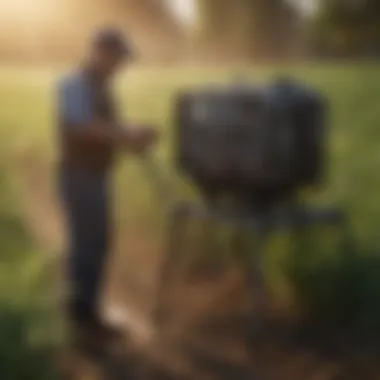Exploring the Raven Spray Controller for Agriculture


Intro
The agricultural sector constantly seeks innovative solutions to improve efficiency and sustainability. Among these advancements, the Raven Spray Controller stands out as a pivotal tool that facilitates precise application of chemicals in farming. This controller not only enhances the effectiveness of agricultural practices but also contributes to environmental preservation. In this article, we will explore its functionalities and features, analyze its practical applications, and examine its impact compared to traditional methods.
Key Concepts and Terminology
Basic Definitions
The Raven Spray Controller is an advanced electronic device designed for managing the application of pesticides, herbicides, and fertilizers. It utilizes sensors and time-controlled systems to regulate the spraying process, ensuring that the right amount of chemicals is applied at the right time. This technology aids farmers in achieving optimal coverage, reducing waste, and lowering operational costs.
Historical Context
Before the advent of systems like the Raven Spray Controller, agricultural spraying was largely manual, relying on simple mechanical devices or human oversight. Often, this involved a high margin of error in chemical application, leading to overuse or underuse of substances. The introduction of electronic controllers in the late 20th century marked a significant shift. This innovation enabled more efficient farming practices, responding to the growing need for sustainability in agriculture.
Recent Innovations and Trends
Technological Advancements
Raven Spray Controllers have revolutionized spraying techniques by integrating GPS technology, variable rate technology (VRT), and advanced data analytics. These enhancements allow for dynamic adjustments based on field variability. Farmers can now utilize real-time data to make informed decisions about when and where to apply chemicals. Furthermore, the ability to collect historical field data helps in planning future applications more effectively.
Sustainable Practices
As global awareness around environmental issues increases, the need for sustainable farming practices has become more urgent. The precision offered by the Raven Spray Controller supports this need by reducing chemical runoff and promoting the responsible use of pesticides and fertilizers. This contributes to healthier ecosystems and supports compliance with stricter regulations concerning chemical use in farming.
Practical Applications and Techniques
Step-by-step Guides
Using the Raven Spray Controller effectively requires understanding its operation thoroughly. Here’s a simplified guide:
- Calibration: Ensure that the system is calibrated correctly to match the chemical being used.
- Setup Parameters: Input the fields' specific needs, including crop type and growth stage.
- Operation Mode: Select the appropriate application mode, whether for broadacre or targeted spraying.
- Monitoring: Keep an eye on the live data feed to adjust as necessary during the operation.
- Post-application Review: After completion, review the collected data for insights into performance and areas of improvement.
Case Studies
Numerous case studies demonstrate the Raven Spray Controller's effectiveness. For instance, a farmer in Kansas reported a 20% reduction in chemical use after integrating the system into his operations. This reduction not only reflected in cost savings but also in increased yield due to better plant health. Similar stories emerge across different geographies, showcasing the broad applicability of this technology.
"Precision technologies like the Raven Spray Controller are essential in adapting agriculture to meet future challenges, especially with resource constraints and regulatory pressures."
In summary, the Raven Spray Controller is redefining agricultural spraying practices. Through advanced technology and sustainable methods, it is empowering farmers to achieve precision and efficiency in their operations. As we move forward, understanding its impact on agriculture becomes critical for all stakeholders involved.
Prolusion to the Raven Spray Controller
The Raven Spray Controller represents a significant advancement in agricultural technology. Efficiency in farming methods has become critical as the industry seeks to meet increasing demands while maintaining sustainable practices. This introduction focuses on the essential aspects of the Raven Spray Controller, emphasizing its functional capabilities and relevance in modern agriculture.
Definition and Purpose
The Raven Spray Controller is an electronic device designed to optimize the spraying of chemicals on crops. It serves numerous purposes in agricultural practices. Primarily, it controls the rate and precise application of fertilizers and pesticides, ensuring they are deployed effectively and efficiently. By utilizing technology, the Raven Spray Controller minimizes the risk of over-application and under-application, both of which can lead to detrimental effects on crop health and the environment. This tool streamlines the spraying process, allowing farmers to achieve targeted results on various crop types. Its integration into farming routines allows for more data-driven decisions.
Importance in Agriculture


In agriculture, the importance of efficiency cannot be overstated. The Raven Spray Controller plays a pivotal role in environmentally responsible farming practices. By applying chemicals with precision, farmers can reduce waste and limit their environmental footprint. Moreover, this tool assists in maximizing crop yields, which is essential for profitability in a highly competitive market.
"Technology in agriculture is not an option anymore; it is a necessity for sustainable practices."
Healthy crop growth relies heavily on appropriate resource management. The ability to customize application based on specific field conditions improves results and promotes a more sustainable approach to farming. Furthermore, the Raven Spray Controller helps align agricultural practices with regulatory standards concerning chemical usage. As awareness of environmental issues grows among consumers, utilizing such technology is becoming increasingly important to maintain market viability.
Key Features of the Raven Spray Controller
The Raven Spray Controller stands as a hallmark of modern agricultural technology, integrating sophisticated systems to enhance the efficiency and precision of chemical application. The key features of this controller are instrumental for farmers aiming to increase productivity while maintaining sustainability. Each component plays a vital role in ensuring that the application of fertilizers and pesticides is carried out effectively, minimizing waste and environmental impact. Understanding these features is essential for any stakeholder looking to improve their agricultural practices.
User Interface Design
The user interface of the Raven Spray Controller is designed with simplicity and efficiency in mind. Farmers can navigate through the software easily, allowing for quick adjustments during operation. The layout is intuitive, presenting crucial information at a glance. For instance, important metrics on pressure, speed, and application rates are displayed in clear, readable formats. This reduces the likelihood of operational errors that may arise from misinterpretation of data. The design not only enhances usability but also decreases the time needed for training, making it accessible even for those who may not be as technologically adept.
Integration with GPS Technology
GPS technology integration is one of the standout features of the Raven Spray Controller. This enables real-time location tracking, ensuring that chemicals are applied uniformly across different terrains. By leveraging GPS data, the controller can adjust the spray patterns based on various factors such as wind direction and speed, enhancing the accuracy of application. Furthermore, this integration aids in mapping fields, allowing farmers to visualize the areas that have already been treated. Such capabilities are fundamental in optimizing the spraying process, leading to better resource management.
Variable Rate Application Capability
The variable rate application feature allows users to customize the amount of chemicals applied across different sections of the field. This means that areas needing more attention can receive higher dosages while others can be treated with minimum amounts. Such customization is based on data gathered from soil testing and crop health assessments. Consequently, this directly translates to reduced chemical usage and costs, while also minimizing environmental risk. Farmers can thus achieve optimal crop health and yield without unnecessary expenditure on resources.
Operational Mechanism of the Raven Spray Controller
Understanding the operational mechanism of the Raven Spray Controller is crucial for any agricultural practitioner. This section provides a detailed look at how to properly implement and utilize this controller, ensuring maximum efficiency and productivity in farming operations. From installation to data management, each component plays a vital role in its success.
Installation Process
The installation of the Raven Spray Controller is a systematic procedure that requires attention to detail. First, it is essential to familiarize oneself with the equipment before any physical setup. The controller needs to be securely mounted on the sprayer, which involves the following steps:
- Power Connection: Connect the controller to the power source of the sprayer. This connection should be made carefully following the manufacturer’s guidelines to avoid any electrical issues.
- Flow Sensor Integration: Install the flow sensor in the appropriate location to accurately monitor the volume of chemicals being applied. Correct positioning is key to ensuring reliable data.
- Nozzle Connection: Ensure the nozzles are firmly connected to the control unit. The selection of nozzles can impact the distribution and efficiency of the application.
Once these components are in place, a preliminary test should be conducted to confirm that the system operates correctly before moving on to the calibration phase.
Calibration and Setup
Calibration is an essential step that allows the Raven Spray Controller to function optimally. Proper calibration ensures that chemical application rates are accurate, which directly influences yield and environmental impact. The following steps outline the calibration process:
- Flow Rate Adjustment: Begin by running the sprayer at different speeds to determine the flow rate. This data informs how adjustments should be made.
- Controller Settings Input: Input the calculated flow rate and desired application rate into the controller settings. This ensures that the system can compensate for speed variations during operation.
- Testing: Conduct several test runs over a small area to validate that the calibration is effective. This may involve adjusting parameters based on test results until desired precision is achieved.
Regular recalibration is recommended to adapt to changing field conditions and chemical properties.
Data Management and Reporting
The Raven Spray Controller not only facilitates efficient spraying but also significantly enhances data management and reporting capabilities. Effective data management is crucial for making informed decisions. The controller's user interface allows for easy tracking of various parameters:
- Application Rates: Operators can monitor real-time application rates, which helps in maintaining consistent performance across different areas of the field.
- Chemical Usage Tracking: Keeping records of chemical inputs aids in evaluating the efficiency of application and understanding cost implications.
- Reporting Features: The system generates detailed reports on application history, which can be beneficial during audits and compliance checks.
This robust data management system not only assists in operational decision-making but also supports environmental stewardship by promoting responsible chemical usage.
"Efficient data logging can lead to better resource management and improved sustainability in farming practices."


Advantages of Using the Raven Spray Controller
The Raven Spray Controller brings numerous benefits to modern agricultural practices. Understanding these advantages is essential for farmers and industry stakeholders who seek to enhance operational efficiency. As agricultural landscapes evolve, the need for precision, sustainability, and cost management becomes paramount. The Raven Spray Controller addresses these needs effectively, transforming how chemicals are applied in farming.
Increased Precision in Spraying
One of the most significant advantages of using the Raven Spray Controller is the increased precision it provides during spraying operations. This device enables farmers to control the flow rates of chemicals with high accuracy. The integration of advanced sensors allows for real-time adjustments based on environmental conditions and crop needs.
Farmers using the Raven Spray Controller report that they can achieve uniform application across varying terrain and crop types. This precision leads to better target coverage and reduces the risk of over-application, which can be harmful to both crops and the environment.
Reduction in Chemical Waste
Another vital benefit of the Raven Spray Controller is its ability to minimize chemical waste. Traditional spraying methods often result in excess chemical being applied, contributing to significant waste and environmental pollution. The Raven system optimizes the amount of chemicals used for each specific application, ensuring that only the necessary amount is sprayed.
This not only helps in reducing input costs but also supports sustainable farming practices. By decreasing chemical runoff into the soil and water supplies, farmers can contribute to the health of their local ecosystems. Importantly, this reduction in waste aligns with the increasing regulatory focus on environmentally responsible farming practices.
Cost-Effectiveness Over Time
Cost management is a crucial factor for any farming operation. The Raven Spray Controller demonstrates exceptional cost-effectiveness over time. While the initial investment might seem significant, the long-term savings on input costs often justify this expense.
Farmers experience savings through reduced chemical expenditures and higher yields due to improved application efficiency. Furthermore, decreased environmental compliance costs and lower damages from chemical overspray add to the financial benefits. The enhanced ability to manage resources effectively leads to more profitable farming practices.
"Investing in the Raven Spray Controller can be seen as a step towards smarter, more sustainable agriculture, where precision pays off in operational costs and environmental stewardship."
Comparative Analysis with Traditional Spraying Methods
Understanding the comparative efficiency of the Raven Spray Controller against traditional spraying methods is crucial in showcasing the advancements in agricultural practices. Traditional methods, often reliant on manual controls, lack the precision and integration that newer technologies provide. The comparison not only sheds light on performance metrics but also contextualizes the importance of adopting modern solutions for improved agricultural productivity.
Efficiency Metrics
When evaluating efficiency metrics, the Raven Spray Controller stands out by optimizing application rates and coverage.
- Operational Speed: Traditional sprayers often operate at a fixed rate, leading to potential overuse or underuse of chemicals. In contrast, the Raven system can adjust in real-time, depending on field conditions and crop needs. This adaptability dramatically enhances overall field efficiency.
- Precision Application: The ability of Raven to deliver precise amounts of chemicals significantly reduces overlap and waste. With traditional systems, overlap can lead to higher chemical use and potentially harmful environmental consequences.
- Time Management: Farmers can complete tasks in a shorter time using automated systems like the Raven Controller. Traditional methods, which require constant manual monitoring, can lead to delays and labor inefficiencies. Data from farms using the Raven system shows a reduction in application time by up to 30% when compared to older methods.
Such metrics demonstrate that adopting the Raven Spray Controller can lead to considerable improvements in both efficiency and resource management.
Environmental Impact Assessment
The environmental ramifications of spraying methods are increasingly under scrutiny, as sustainable agriculture becomes a paramount objective.
- Reduction in Chemical Runoff: One of the most significant advantages of the Raven Spray Controller is its ability to limit chemical runoff. Traditional methods often lead to unintended application near water bodies or environmentally sensitive areas. With precise application features, Raven minimizes these risks, protecting ecosystems and water quality.
- Chemical Usage: Comparatively, the reduced volume of chemicals required with the Raven Controller not only saves costs for farmers but also lessens the ecological burden. Studies show that precise application can cut chemical use by 20-50% depending on the crop and situation.
- Improved Soil Health: The integration of advanced monitoring and data capabilities allows for better decision-making regarding soil health. Overusing chemicals can cause soil degradation, a crucial concern in traditional practices. Raven’s data-driven approach promotes healthier soil conditions by ensuring more targeted usage of fertilizers and pesticides.
"Adopting more efficient spraying technologies isn't just a matter of cost; it's about ensuring we protect the land that sustains us."
In summary, the comparative analysis of the Raven Spray Controller against traditional spraying methods highlights substantial improvements in efficiency and sustainability. By focusing on metrics that matter, such as operational speed and environmental impact, stakeholders can make informed choices that align with future agricultural needs.
Case Studies of Raven Spray Controller Implementation
Case studies serve as a vital component in understanding the real-world impact of the Raven Spray Controller within agricultural settings. They provide practical examples that illustrate how this technology enhances efficiency in various farming practices. By examining these cases, stakeholders such as farmers, agronomists, and technology developers can gain insights into the specific benefits, challenges faced, and long-term implications of integrating the Raven system into their operations.


The significance of these case studies lies in their ability to translate theoretical knowledge into practical results. They demonstrate how the Raven Spray Controller can positively influence productivity, reduce waste, and promote sustainable farming techniques.
Success Stories
Numerous farms have successfully implemented the Raven Spray Controller, leading to remarkable improvements in their spraying operations. One notable case involved a mid-sized corn and soybean farm in Iowa. The farmer reported a significant reduction in herbicide usage. With the use of variable rate technology, the farmer tailored applications based on field variability. This led to a 20% decrease in chemical inputs while maintaining crop yields. Similarly, a vineyard in California utilized the controller to apply fungicides with greater precision, seeing a 30% reduction in disease incidence and improving overall grape quality.
Key aspects of these success stories include:
- Enhanced Precision: Farmers can now apply chemicals with pinpoint accuracy.
- Cost Savings: Reductions in chemical usage translate to lower operational costs.
- Higher Yields: Crop health and quality improve through better resource management.
These examples illustrate how farmers are leveraging technology to make informed decisions that positively affect their bottom line.
Lessons Learned
While the benefits of implementing the Raven Spray Controller are clear, there are also valuable lessons learned from these case studies that can inform future users. A common theme across several cases is the necessity for proper training. Farmers who received comprehensive education on operating the system maximized its potential, while those who did not faced steep learning curves.
Another important lesson involves the importance of regular calibration and maintenance of the equipment. Case studies indicated that neglecting these aspects can lead to suboptimal performance and decreased efficiency. Additionally, some farmers faced challenges when integrating the Raven Spray Controller with existing machinery. This highlights the need for compatibility assessments before implementation.
In summary, the case studies of Raven Spray Controller implementation serve as important reference points. They elucidate not only the success achieved through precision agriculture but also the learning experiences that can guide future adopters. The path to efficiency is paved with insights derived from both accomplishments and missteps, making it essential for farmers and stakeholders to consider these real-world examples as they embark on their own journey with agricultural technology.
Future of Agricultural Spraying Technologies
The realm of agricultural spraying is on the brink of significant transformation. As we explore the future of agricultural spraying technologies, it becomes evident that advancements will focus on precision, efficiency, and sustainability. These elements are critical in a world where agricultural practices face increasing scrutiny regarding their environmental impact and resource management. By assessing upcoming innovations and the necessary regulatory frameworks, stakeholders can ensure that these technologies align with both agricultural goals and ecological considerations.
Innovations on the Horizon
Several promising innovations are set to revolutionize the agricultural spraying landscape. These advancements include:
- Drone Technology: With their ability to cover large areas quickly, drones are being utilized for aerial spraying. They allow for precision application, minimizing waste and reducing exposure to chemicals for operators.
- Automated Ground Equipment: Robotic systems and autonomous tractors equipped with advanced sensors can detect crop health and apply treatments accordingly. This capability enhances targeted spraying and reduces overall chemical use.
- Smart Sensors and IoT: Internet of Things (IoT) devices are integrating with spraying systems for real-time data collection. These sensors can monitor environmental conditions and crop needs, providing timely and accurate application schedules.
- Biologically Derived Solutions: There is an increasing emphasis on using bio-pesticides and fertilizers that have less environmental impact. These products require effective delivery systems, which can be optimized through advanced spraying technologies.
Adopting such innovations can lead to enhanced resource efficiency and cost savings for farmers. The precision these technologies offer is not only beneficial for yields but also for the surrounding ecosystem.
Regulatory Considerations
As new technologies emerge, regulatory considerations become paramount. Policymakers must establish guidelines to ensure that agricultural innovations do not compromise safety or environmental integrity. Some pressing considerations include:
- Safety Standards: Establishing standards for the safe usage of aerial drones and automated equipment is crucial. This includes addressing potential risks to workers and nearby communities.
- Environmental Regulations: As the methods of applying chemicals change, regulations need to adapt to mitigate risks to biodiversity and waterways. These frameworks should encourage sustainable practices while maintaining productivity.
- Testing and Certification: New products and technologies should undergo rigorous testing before widespread adoption. Certification programs can help to validate the effectiveness and safety of these innovations.
Finale
The conclusion of this article highlights the pivotal role the Raven Spray Controller plays in enhancing agricultural practices. This technology emerges as a critical tool for modern farmers seeking efficiency in their operations while also being mindful of environmental concerns. The integration of advanced features such as precise application rates, GPS technology, and data management points to a future where farming is not only more productive but also more sustainable.
Summary of Key Points
In summary, several key aspects regarding the Raven Spray Controller have been discussed:
- Technological Integration: The controller’s ability to work alongside GPS technology allows for specific targeting of spray applications, optimizing input use and minimizing waste.
- Precision and Efficiency: Its capacity for variable rate application ensures that only the necessary amounts of chemicals are utilized for different areas of a field, enhancing both crop yield and safety.
- Real-World Impact: Case studies illustrate not only the success stories arising from its deployment but also valuable lessons that have been learned, which can inform future agricultural practices.
- Environmental Considerations: By reducing chemical runoff and waste, the Raven Spray Controller supports sustainable farming practices, contributing to a healthier ecosystem.
Final Thoughts on Technology in Agriculture
Reflecting on the technological advancements in agriculture, it becomes clear that tools like the Raven Spray Controller are no longer luxuries, but necessities. Farmers today face numerous challenges, from economic pressures to environmental regulations. Thus, it is essential to embrace technological innovations that address these issues effectively.
As the industry continues to evolve, the potential for future advancements in agricultural spraying technologies holds promise. Continuous improvement and adaptation will be key in ensuring that agriculture meets the demands of a growing population while maintaining environmental stewardship. The Raven Spray Controller exemplifies how embracing modern technology can lead to better practices, driving efficiency and sustainability in agricultural operations.
"Technology in agriculture is not just about increasing yields; it is about improved management of resources for a sustainable future."
By discussing the importance and benefits of the Raven Spray Controller, this article serves as a guide for farmers and enthusiasts alike. Understanding its features and functionality is crucial for making informed decisions that can enhance efficiency and sustainability in agriculture.















